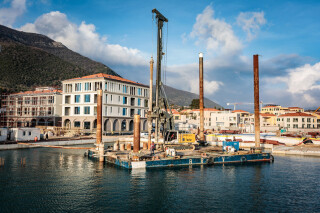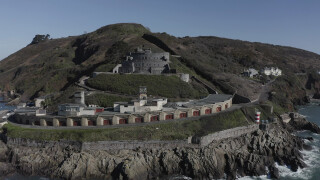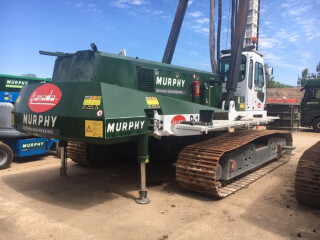The company is working for main contractor Balfour Beatty on the £63m A19 road improvement scheme between Norton and Wynyard for Highways England. The contract is part of the government’s first five-year Road Investment Strategy (RIS1) programme which got underway in April.
Sheet Piling UK became involved in the A19 road improvement scheme under a professional services contract to provide the delivery consortium with advice on all aspects of the design and installation of the required sheet pile package.
The company says its early involvement in the project helped to develop improvement to the scheme’s original sheet pile proposal and generated significant cost and programme savings.
“Our in-depth technical analysis and hands-on know-how helped to ensure that a cost-effective solution was proposed to the group,” said the company.
As part of the scheme, a 5km stretch of the A19 trunk road between Norton and Wynyard will be increased in capacity from two to three lanes.
In total, approximately 2.5km of permanent steel sheet piles are being installed to widen both northbound and southbound carriageways. The company is using a combination of Emirates Steel sheet piles and Arcelor Mittal steel sheet pile sections.
This article was first published in the Jul/Aug 2020 issue of The Construction Index magazine. Sign up online.
Sheet Piling UK is using its own custom-designed ABI TM12/15 LR piling rig – which it says is the world’s first long-reach telescopic leader rig – in order to reduce the need for extensive enabling works on this job.
The rig was designed and developed two years ago, in partnership with manufacturer and distributor ABI Equipment, specifically for use on those sheet piling projects associated with the widening within existing earthworks – smart motorways and HS2 being key target markets.
The rig has a maximum 8.1m horizontal reach (measured from the centre of the slew ring to the pile line), which the company says is a full 3m further than any other rig currently available.
On road-widening projects, such as the A19 improvement, the rig has a significant advantage in reducing, or even eliminating, enabling works and piling platform construction. The company says that such activities are notoriously problematic on such projects in terms of logistics, programme and cost.
The long reach allows the machine to stand on the existing carriageway and drive piles on the required pile line, with all the advantages of speed and convenience that being able to pile-drive from existing infrastructure brings.
This benefit dramatically speeds up an infrastructure widening project and reduces the overall construction costs, says the company.
Predicted savings of up to £60,000 can be realised on a typical 100m sheet pile wall installation. There are also significant environmental, logistical, customer perception and health & safety benefits to be derived from using the new long-reach sheet piling rig, says Sheet Piling UK.
Since its launch in late 2018, the ABI TM12/15 LR rig has been used extensively on Highways England’s programme of ‘smart’ motorway upgrading schemes including the M23, M62 and M1.
The upgrade works to the A19 in Stockton-on-Tees are scheduled for completion in spring 2022.
Liebherrs invade luxury resort
Montenegrin contractor Briv Construction is currently using a Liebherr LB24 piling rig for deep foundation work at Portonovi, a new luxury resort development in the Bay of Kotor on the Adriatic coast.

Briv Construction is using the barge-mounted Liebherr rig to stabilise a large area below a beach, a task that requires a total of 70km of bored piles, 22,000m3 of concrete and 3,400 tonnes of reinforcement.
The piles are 32m deep, up to 800mm in diameter and are all fully-cased. The Liebherr rig is being used with a combination of rock-drilling augers and clamshell buckets and while Briv calculated that it would progress with the installation of one pile per day, it has so far managed to install as many as four piles – including concreting.

Briv is also installing drilled piles to provide foundations for the pier that serves the new luxury hotel, as well as breakwaters in the harbour area.
Here, the company is using a combination of Liebherr machines, including two LB 24 rigs, an LRB 125 rig, an HS 873 HD duty-cycle crawler crane and a Liebherr LTM 1100 telescopic mobile crane.
CAN-do attitude
Ground engineering specialist CAN Geotechnical has landed a contract to carry out geotechnical stabilisation work at Fort Bovisand, near Plymouth, where both its specialist access capability and drilling expertise will be use in the redevelopment of the historic Victorian fort.

But before any reconstruction begins, two gullies immediately beneath the access road leading into the fort complex need to be stabilised. Their location, along the top of the cliff face, will require the use of specialist equipment not only to carry out rock drilling and nailing, but also to carry out the work at height.
The project’s geotechnical designer, Red Rock Geoscience, has specified a soil nail and facing solution to stabilise the gullies and prevent further erosion from undermining the access road. The eastern gulley will have 195 R32 stainless steel soil nails installed in a grid pattern over the cliff face, while the western gulley needs 127 of the same type of soil nails, and both gullies will be faced with steel netting and erosion matting.
CAN is now carrying out the work using an excavator-mounted hydraulic drill rig to install the upper bolts of the netting system, drilling rows of nails in the face of the cliff.
Temporary anchors will then be installed to support CAN’s special A-frame cliff-mounted drill rigs which the company designed and made itself.
These A-frames enable the drilling crews to move the rigs to each soil nail location on the cliff face using winches. They will access the equipment by abseiling down onto the cliff face and working while suspended from ropes.
Once the soil nails have all been installed, specialist marine contractors will carry out repairs to a defensive wall and install a rock protection system at the base of the cliffs to protect from future wave action.
Thus reinforced, the cliff and gulleys will then no longer need the temporary weight limit currently in force on the access road.
Piggy-back power
Murphy Ground Engineering – the piling division of J Murphy & Sons – has improved site efficiency in its piling fleet by mounting compressors directly onto its rigs.

Moving a diesel compressor around is not always easy on a construction site – especially on rough ground – and very often the only way of getting the machine to where it’s needed is to lift it in by crane. This is time-consuming, inefficient and costly.
So Murphy turned to compressor manufacturer Atlas Copco for a solution – which it provided in the form of its XAS 88 frame-mounted compressors. Murphy has mounted the compressors (which also feature an in-built 9kVA generator) on the back of its Llamada rigs, making them self-sufficient and independent of other on-site equipment.
The XAS 88 is the largest in Atlas Copco’s 8-Series compressor range. Powered by a four-cylinder Kubota V1505 diesel engine, it delivers and air flow of 175 cubic feet per minute (cfm) at a pressure of 7bar. This is used to clean out the rig’s concrete delivery system by propelling a foam ball along 80m of pipework.
The 8-Series compressors are normally delivered as single-axle towable units and while the XAS 88 is the largest in the range, it still weighs only 750kg – more than 150kg less than its nearest competitor, according to the manufacturer.
Although the XAS 88s were mainly chosen just for the air supply, their on-board generators have also been put to good use, supplying power for the lights in the tool cabins that accompany the piling rigs and as a portable power source for the many handheld power tools and welders used on site.
This article was first published in the Jul/Aug 2020 issue of The Construction Index magazine. Sign up online.
Got a story? Email news@theconstructionindex.co.uk


